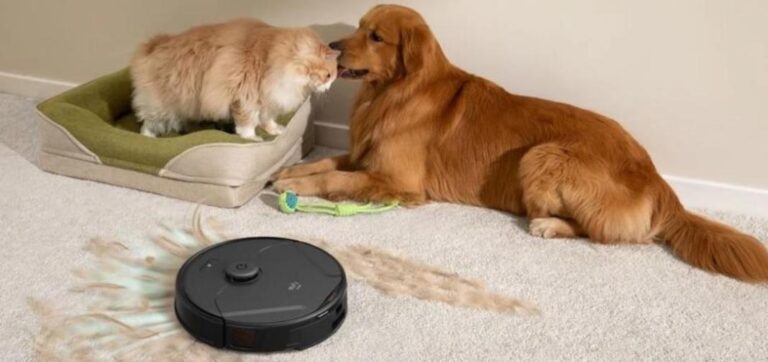Pet owners cherish their furry friends, but not the odors they sometimes leave behind. Carpets, with their dense fibers, can easily trap unpleasant pet smells, making home life less enjoyable. So, how to remove pet odors from carpets?This guide aims to help you achieve clean, fresh floors by addressing these odors effectively. Here, you will discover practical methods to remove pet odors, using both natural and advanced cleaning techniques. Pet accidents no longer mean lingering smells; with the right steps, your carpets can smell fresh as a daisy. Dive in to explore how to deal with these issues immediately and ensure lasting results, all while avoiding common pitfalls that can make the problem worse.
Why Pet Odors Linger in Carpets
Pet odors often persist in carpets due to the organic components of urine, saliva, or dander. Each of these contains proteins and fats that penetrate carpet fibers deeply. When not addressed promptly, bacteria can break down these substances, releasing unpleasant odors. Carpets provide a perfect environment for such activities—being warm, fabric-based, and often slightly moist, especially in high pet traffic areas or if spills aren’t cleaned effectively. Additionally, even the best-sealed floors below carpets can become compromised if cleaning isn’t thorough, leading to trapped moisture. Over time, these factors combine to make odors more stubborn and harder to eliminate. Furthermore, pets might return to marked spots, encouraged by the odor remnants, exacerbating the issue. Understanding these dynamics helps in strategizing better cleaning practices aimed at eliminating odors and preventing recurrence.
How to Clean Pet Odors from Carpets
Step-by-Step Immediate Response to Accidents
When a pet accident occurs, swift action is critical. First, blot up as much liquid as possible using a paper towel or clean cloth—apply firm, steady pressure, but never scrub, as this risks pushing the mess deeper into carpet fibers. Once the area is soaked, mix equal parts white vinegar and water, lightly spray the spot, and let it sit for 5–10 minutes—the acidity effectively neutralizes urine odors. Blot again with a fresh towel until the surface is nearly dry. For stubborn smells, finish with a sprinkle of baking soda, allow it to sit, then vacuum it up.
DIY Natural Remedies That Work
Baking soda is a natural favorite for tackling carpet odors due to its powerful odor-absorbing capabilities. Sprinkle a generous layer on freshly vacuumed, dry carpet and leave it for at least a few hours—or ideally overnight—to allow it to neutralize smells at their source. For long-lasting freshness, mix in 10–20 drops of essential oil such as lavender, lemon, or eucalyptus, which not only scent the carpet but also add mild antimicrobial benefits. After waiting, vacuum thoroughly—deep-pile carpets may need brushing beforehand to work the mixture into fibers. Repeat for stubborn odors. This eco-friendly method avoids harsh chemicals and is both safe and budget-friendly.
Steam Cleaning
Steam cleaning offers a deep, restorative clean by delivering high-temperature vapor deep into carpet fibers, breaking down embedded dirt, bacteria, and allergens. To effectively address pet odors, rent or buy a carpet-grade steam cleaner, fill it with hot water and a pet‑friendly odor‑removal solution, and glide it slowly and evenly—avoiding oversaturation—to ensure complete extraction. This process not only neutralizes lingering smells, but the heat also sanitizes and disinfects, killing over 99% of odor-causing bacteria and reducing allergens. For best results, pair steam cleaning with pre-treatment using enzymatic solutions or baking soda to tackle organic stains before steaming, leaving your carpets fresh, hygienic, and notably rejuvenated.
Professional Cleaning for Persistent Odors
Professional carpet cleaning is the gold standard for eliminating deep‑seated pet odors. Technicians use ultraviolet (UV) lights to detect hidden urine spots—essential since stains often penetrate padding and subflooring. They apply enzymatic or P.U.R.T.® treatments to chemically neutralize urine crystals and odor-causing compounds at their source. This is followed by Hot Carbonating Extraction (HCE)—or steam cleaning—which injects hot, carbonated water and powerful agents into fibers and immediately vacuums out contaminants. High-powered vacuums and odor-neutralizing solutions typically reach the padding and subfloor; in extreme cases, technicians may replace both padding and carpet to ensure a fully fresh result.
What to Avoid When Dealing with Pet Odors
Avoid using harsh chemical cleaners indiscriminately, as these can damage carpet fibers and affect indoor air quality. Instead, choose cleaners specifically formulated for pet odors. Refrain from scrubbing stains vigorously; this can distort carpet fibers and spread the stain further. Another common mistake is over-wetting during cleaning. Excess moisture can seep into the carpet pad, fostering mold growth and worsening smells. Skipping a thorough drying process after cleaning can lead to odor problems, so always ensure carpets dry completely. Finally, never ignore small accidents or repeatedly marked spots. Attending to them promptly prevents long-term damage and more challenging remediation. Being proactive, using the right products, and understanding these pitfalls will help maintain clean, odor-free carpets even in the most pet-friendly homes.
Conclusion
Keeping carpets free from pet odors enhances both the look and comfort of your home. By following these strategies—acting swiftly after accidents, utilizing effective natural remedies, and employing professional techniques like steam cleaning—you can successfully manage pet-related smells. Remember to avoid common cleaning mistakes to maximize your results. With diligence and the right practices, every pet owner can enjoy a fresh and inviting home, sharing life with pets without the accompanying odors. Implement these tips today for a harmonious and spotless living environment.

